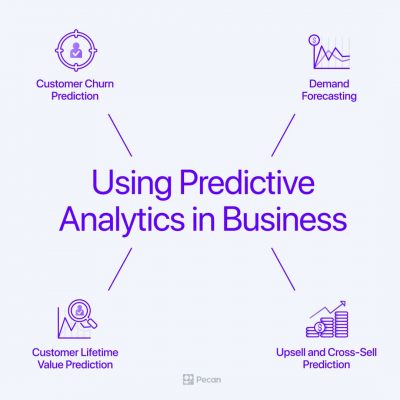Welcome to the fifth article in our 3-Minute Nutshell series. We answer FAQs about predictive analytics in just a few minutes of your time! Get up to speed on the key things you need to know to start your business’s journey toward AI success. Catch up with the series now:
- What is predictive analytics?
- Is predictive analytics the same as data science, machine learning, and AI?
- What skills do you need to do predictive analytics?
- Can predictive analytics be automated?
… and now: What are the best uses for predictive analytics in business?
When you feel confident about a decision, it’s a great feeling. You’ve considered the possible results of different choices. You’re optimistic that your decision will provide the best possible outcome. You move forward with a positive, upbeat attitude.
Predictive analytics shows you what will likely occur in your business’s future using data you’ve already collected. With that knowledge, you can make more of those confident decisions. You can anticipate likely outcomes and future events with greater certainty.
That confidence is available across all the different uses of predictive analytics. But there are specific applications where this technology’s value and reliability have been battle-tested and proven.
Let’s explore some business problems where predictive analytics can benefit business leaders.
Customer Churn
Nobody likes losing a customer. But sometimes, it seems impossible to identify when and why different customers might slow down or stop interacting with your business. Staring at spreadsheets and visualizations of historical data can’t resolve this problem.
Fortunately, predictive analytics can help you identify which customers may be nearing the end of their relationships with your company. This method can also reveal why they may be likely to churn.
Predictive models analyze thousands of customer data points to uncover patterns that matter most in customer churn. Importantly, when built well, these models can also provide predictions for each customer. You can create highly refined customer segments around that information.
With those segments, plan more personalized campaigns and outreach about new products, services, or offers. And, if you need to reactivate lapsed customers, predictive analytics can also help refine winback campaigns for impressive results.
Customer Lifetime Value
Got a new customer? You can more confidently know early in their journey with you whether they’ll be a high-value customer over the long term by predicting customer lifetime value. You can see which potential or new customers will be most profitable early on in their journey with you.
Predictive models based on your historical data can compare their behavior to that of existing customers. The models then predict the new customers’ activity in the future.
With that in mind, you can tailor your likely VIPs’ customer experience to ensure they stick around. For example, you can provide special event invitations, customize offers, or upgrade customer service.
Demand Forecasting
Who would’ve known a few years ago that “supply chain” would become a household term? Luckily, predictive analytics can help smooth out potential supply chain issues with AI-powered demand forecasting. This approach deepens your understanding of customers’ future demand for products and services.
That advance knowledge can then shape better and earlier business decisions. For example, you might change manufacturing plans, optimize staffing, and anticipate seasonal changes.
You can enrich demand forecast models with outside data sets, such as weather forecasts and macroeconomic trends. This enrichment increases accuracy and further improves customer experiences. With an AI-powered predictive analytics tool involved in forecasting, your planning can be much better informed.
Upsell and Cross-Sell Prediction
You can make a significant impact by upselling and cross-selling products and services to your existing customer base. These approaches efficiently grow your revenue, drive greater customer loyalty, and increase your share of wallet. Advanced analytics can determine who’s most likely to buy additional services, complementary products, or other add-ons. You can also predict when customers will likely purchase upgraded products or premium services.
Predictive analytics reveals who’s most likely to be receptive to outreach for these offers. This approach can even tell you when to reach out and through what channel.
Whatever business you’re in, predictive analytics can guide you toward more data-driven, certain decisions that will yield better outcomes. Learn more about implementing predictive analytics in our hands-on, in-depth guide. The guide leads you through essential questions to consider.
Get ready for a confidence boost — and a boost to your results.






